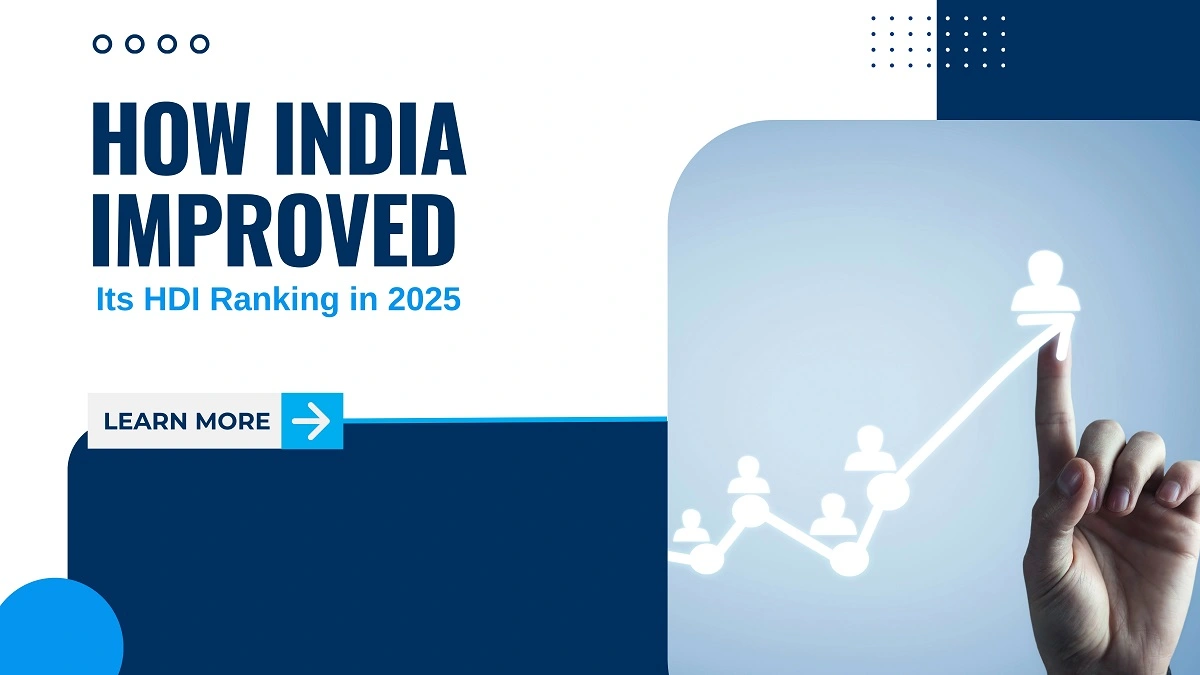Home » The Big Shift: How India Improved Its HDI Ranking in 2025

India has made remarkable strides in human development, climbing to the 130th spot out of 193 countries in the 2025 Human Development Index (HDI) rankings, as per the United Nations Development Programme (UNDP) report. This upward movement from 133 in 2022 (published in 2024) signals a positive shift in India’s focus on health, education, and income.
For students eager to understand India’s progress and its implications, this blog breaks down the essentials of HDI, India’s achievements, challenges, and what lies ahead in a simple, engaging way.
The Human Development Index (HDI) is a tool developed by the UNDP to measure a country’s progress beyond just economic growth. It focuses on three core pillars of human well-being:
Each dimension is scored between 0 and 1, and the HDI is the geometric mean of these scores. A higher HDI value (closer to 1) places a country in categories like “very high,” “high,” “medium,” or “low” human development. India’s journey in this index showcases its efforts to improve quality of life for its 1.4 billion people.
In 2025, India’s HDI score climbed to 0.685 from 0.676 in 2023, solidifying its status in the “medium human development” tier while nearing the “high” development benchmark of 0.700 or higher.. Key achievements include:
Since 1990, India’s HDI has surged by over 53%, outpacing global and South Asian averages, a testament to long-term investments in human-centric policies
India’s HDI improvement stems from targeted government initiatives and systemic reforms:
These efforts reflect India’s commitment to people-centric development, aligning with global Sustainable Development Goals (SDGs).
India’s HDI progress isn’t uniform across its states and union territories. According to subnational HDI data, states like Kerala, Goa, and Delhi lead the pack due to:
However, states like Bihar, Uttar Pradesh, and Jharkhand lag behind, grappling with lower literacy, inadequate healthcare, and higher poverty rates. These disparities highlight the need for region-specific policies to ensure balanced development.
Despite progress, India faces significant hurdles:
Addressing these challenges requires sustained policy focus and inclusive growth strategies.
India’s 130th rank places it alongside Bangladesh (130th) but behind neighbours like Sri Lanka (89th) and China (78th), both in the “high human development” category. Nepal (145th) and Pakistan (168th) trail India. Worldwide, Iceland leads the HDI with a score of 0.972, whereas South Sudan trails at 0.388. India’s progress outpaces many developing nations, but it lags behind OECD countries, where recovery from global crises has been faster. The global HDI growth has slowed, with 90 countries stagnating or declining, making India’s upward trajectory noteworthy.
To maintain and accelerate HDI growth, India must:
India’s steady HDI climb reflects its potential to become a global leader in human development. By addressing inequalities and embracing innovation, India can cross the “high human development” threshold by 2030, creating a brighter, more equitable future for its citizens.
Also Read
One Nation One Subscription Scheme for Students
India Set To Become Global Consumption Capital
Free IIT Courses for Entrepreneurs on Startup
Digital Transformation in Education
From
Lingaya’s Vidyapeeth
Best Colleges in Delhi NCR
RECENT POSTS
CATEGORIES
TAGS
Agriculture Agriculture future AI Architecture artificial intelligence Bachelor of Commerce BA English BA Psychology BTech AIML BTech CSE BTech cybersecurity BTech Engineering Business management career Career-Specific Education career guide career option career scope Civil engineering commerce and management Computer Science Computer science engineering Data science degree education Engineering Engineering students English Literature english program Fashion Design Fashion design course Higher Education Journalism journalism and mass communication law Law career Machine Learning mathematics MBA MBA specialization Mechanical Engineering Pharmacy Psychology Research and Development students
Nachauli, Jasana Road, Faridabad, Haryana
Address: C-72, Second Floor, Shivalik, Near Malviya Nagar,
Above HDFC Bank, New Delhi 110017
Landline No. - 011-46570515 / 45138169 / 41755703
Mobile No. - +91-7303152412 / +91-7303152420 / +91-9311321952
Toll Free: 1800-120-4613
Mobile : 8447744303 | 8447744304 | 8447744306 | 8447744309
8700003974 | 8700003411 | 8700003749
Copyrights © 1998 - 2025 Lingaya's Vidyapeeth (Deemed To Be University). All rights reserved.
LV only conducts physical/online verification of any document related to examination on the following email id:
It is important to note that the following email IDs and domains are fraudulent and do not belong to our university.